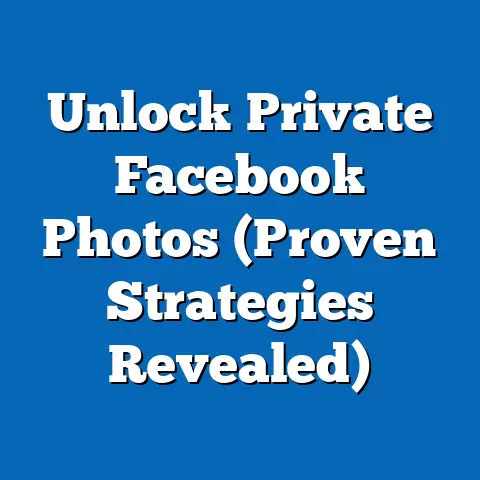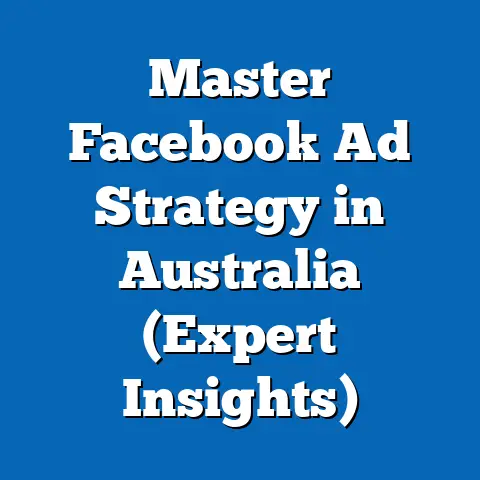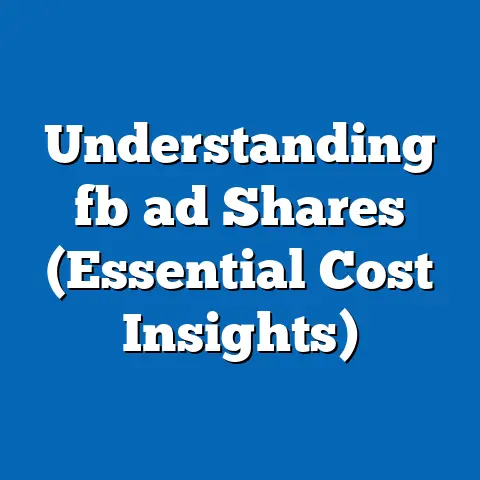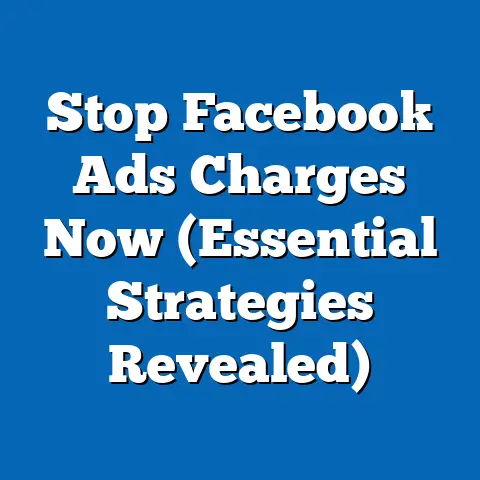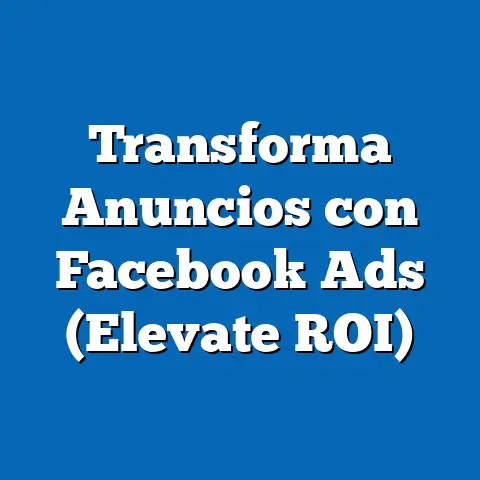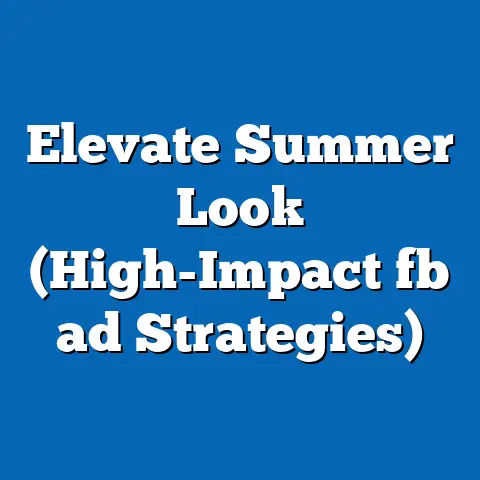Achieve Facebook Ads Success (Proven Strategies Uncovered)
Facebook advertising. Just the thought of it can send shivers down the spines of even seasoned marketers. I know, because I’ve been there! The platform is constantly evolving, algorithms shift like sand dunes, and what worked yesterday might be a complete flop today. But let me tell you, despite the challenges, Facebook Ads remain one of the most powerful tools in the digital marketing arsenal. Why? Because it puts your message in front of billions of potential customers.
I’ve spent years diving deep into the world of Facebook Ads, and I’ve seen firsthand what works and what doesn’t. I’ve celebrated campaign successes and learned from costly mistakes. And in this article, I’m going to share those hard-won lessons with you. Forget the generic advice; this is about actionable strategies, real-world examples, and the kind of insights that can truly transform your campaigns. We’ll explore how to understand your audience, craft compelling ad copy and visuals, choose the right ad format, set up effective targeting and budgeting, and analyze performance to continually improve. If you’re ready to unlock the true potential of Facebook Ads and drive tangible results for your business, then let’s get started.
1. Understanding Your Audience: The Foundation of Every Successful Campaign
Before you even think about crafting an ad, you need to know who you’re talking to. This is Marketing 101, but it’s surprising how many businesses skip this crucial step. Imagine shouting into a crowded stadium without knowing who’s in the stands – you might get lucky, but you’re mostly wasting your breath (and your budget).
I remember working with a local bakery that wanted to promote their new line of gluten-free pastries. They launched a generic ad campaign targeting “food lovers” in their city. The results? Minimal engagement and a lot of wasted ad spend. We took a step back and started digging deeper. We discovered that their ideal customer wasn’t just any food lover; it was someone specifically interested in gluten-free options, often with dietary restrictions or health concerns. We refined their targeting to focus on individuals interested in gluten-free diets, celiac disease, and healthy living. The result? A significant increase in engagement and a flood of orders for their gluten-free goodies.
The key is to create detailed buyer personas. Think beyond basic demographics like age and location. Consider:
- Interests: What are their hobbies? What pages do they follow? What content do they engage with online?
- Pain Points: What problems are they trying to solve? What are their frustrations?
- Online Behavior: Where do they spend their time online? What devices do they use? What type of content do they prefer?
- Motivations: What drives their purchasing decisions? Are they motivated by price, quality, convenience, or social status?
Facebook offers powerful tools to help you gather these insights. The Audience Insights tool (though now less robust due to privacy changes) can still provide valuable data about your existing audience and potential customers. You can analyze demographics, interests, page likes, and even purchase behavior. Pay close attention to the “Page Likes” section – this can reveal niche interests and communities that you might not have considered.
Takeaway: Don’t guess; research. Use Facebook’s tools and your own customer data to create detailed buyer personas. This will inform every aspect of your campaign, from ad copy to targeting.
2. Crafting Compelling Ad Copy & Visuals: Grabbing Attention in a Scroll-Happy World
Okay, you know your audience. Now, how do you grab their attention in a world saturated with content? The average person is bombarded with thousands of ads every day. To stand out, your ad copy and visuals need to be nothing short of compelling.
Ad Copy: Speak Their Language
- Headline: This is your first (and sometimes only) chance to make an impression. Keep it short, punchy, and benefit-driven. Use power words and ask questions to pique curiosity.
- Body Text: Expand on the headline and highlight the key benefits of your product or service. Use clear, concise language and avoid jargon. Focus on solving their problems and addressing their needs.
- Call-to-Action (CTA): Tell them exactly what you want them to do. Use strong action verbs like “Shop Now,” “Learn More,” or “Sign Up.” Make the CTA button prominent and visually appealing.
I once worked with an e-commerce store selling handmade jewelry. Their initial ad copy was generic and focused on the features of the jewelry (“Handcrafted with love”). We revamped their copy to focus on the benefits: “Express Your Unique Style” and “Find the Perfect Gift.” We also added a sense of urgency with phrases like “Limited Edition” and “Shop Now Before They’re Gone.” The result? A significant increase in click-through rates and conversions.
Visuals: Show, Don’t Just Tell
- Images: Use high-quality, visually appealing images that showcase your product or service in the best light. Avoid stock photos; use authentic images that resonate with your target audience.
- Videos: Videos are incredibly engaging and can be used to tell a story, demonstrate a product, or share testimonials. Keep videos short and sweet (under 30 seconds) and optimize them for mobile viewing.
- Branding: Maintain consistent branding across all your ads. Use your brand colors, fonts, and logo to create a cohesive and recognizable identity.
Remember, your visuals should always be relevant to your ad copy and target audience. For example, if you’re targeting millennials, use images and videos that reflect their style and values.
Example Breakdown:
Let’s look at a hypothetical example: An ad for a language learning app.
- Headline: “Unlock Your Global Potential: Learn a New Language in 30 Days!” (Benefit-driven, creates intrigue)
- Body Text: “Imagine ordering coffee in Paris, negotiating a deal in Tokyo, or connecting with new friends from around the world. Our app makes language learning fun, easy, and effective. Start your free trial today!” (Highlights benefits, addresses needs, clear CTA)
- Visual: A vibrant image of people from different cultures interacting and smiling, showcasing the joy of connecting through language.
- CTA: “Start Free Trial”
Takeaway: Craft ad copy that speaks directly to your target audience and highlights the benefits of your product or service. Use high-quality visuals that grab attention and reinforce your message. A/B test different versions of your ad copy and visuals to see what resonates best.
3. Choosing the Right Ad Format: Tailoring Your Message to the Platform
Facebook offers a variety of ad formats, each with its own strengths and weaknesses. Choosing the right format is crucial for maximizing engagement and achieving your campaign goals.
- Image Ads: Simple, versatile, and effective for driving traffic to your website. Use high-quality images and compelling ad copy.
- Video Ads: Highly engaging and ideal for telling a story, demonstrating a product, or sharing testimonials. Keep videos short and optimized for mobile viewing.
- Carousel Ads: Allow you to showcase multiple products or services in a single ad. Great for e-commerce businesses and for highlighting different features of a product.
- Collection Ads: Designed for mobile shopping, collection ads showcase a catalog of products in a visually appealing format.
- Lead Ads: Allow you to collect leads directly from Facebook without sending users to your website. Great for generating leads for sales teams or for building your email list.
- Instant Experience Ads: Full-screen, mobile-optimized experiences that allow users to interact with your brand in an immersive way.
- Stories Ads: Short, vertical videos or images that appear in Facebook Stories. Great for reaching a younger audience and for creating a sense of urgency.
I once ran a campaign for a travel agency promoting a new tour package to Italy. We initially used image ads, but the results were underwhelming. We decided to switch to video ads, showcasing breathtaking scenery, delicious food, and happy travelers enjoying the tour. The video ads generated significantly more engagement and resulted in a surge of bookings.
The key is to choose the ad format that best aligns with your campaign goals and target audience. If you’re trying to drive traffic to your website, image ads or video ads might be the best option. If you’re trying to generate leads, lead ads or instant experience ads might be more effective. If you’re trying to showcase multiple products, carousel ads or collection ads might be the way to go.
Takeaway: Experiment with different ad formats to see what works best for your business. Consider your campaign goals, target audience, and budget when making your decision.
4. Setting Up Targeting and Budgeting: Reaching the Right People Without Breaking the Bank
Even the most compelling ad copy and visuals will fall flat if they’re not shown to the right people. Facebook’s targeting options are incredibly powerful, allowing you to reach specific audiences based on demographics, interests, behaviors, and more.
- Core Audiences: Target users based on demographics, interests, and behaviors. This is a great option for reaching a broad audience with general interests.
- Custom Audiences: Target users who have already interacted with your business, such as website visitors, email subscribers, or customers. This is a great option for retargeting and building customer loyalty.
- Lookalike Audiences: Create audiences that are similar to your existing customers or website visitors. This is a great option for expanding your reach and finding new customers who are likely to be interested in your products or services.
- Detailed Targeting: Combine multiple targeting options to create highly specific audiences. This allows you to reach users with very niche interests or behaviors.
I’ve seen firsthand how effective lookalike audiences can be. I once helped a subscription box company create a lookalike audience based on their existing customer base. The resulting ad campaign generated a significant increase in new subscribers at a fraction of the cost of their previous campaigns.
Budgeting Strategies:
- Daily Budget: Set a fixed amount that you’re willing to spend each day. This is a good option for campaigns that run continuously.
- Lifetime Budget: Set a total amount that you’re willing to spend over the entire duration of the campaign. This is a good option for campaigns with a specific end date.
- A/B Testing: Test different targeting options and budgeting strategies to see what performs best. This is crucial for optimizing your campaigns and maximizing your ROI.
Remember, your budget should align with your campaign goals. If you’re trying to reach a large audience, you’ll need a larger budget. If you’re targeting a niche audience, you can get away with a smaller budget.
Takeaway: Leverage Facebook’s powerful targeting options to reach the right people with your ads. Experiment with different targeting strategies and budgeting options to see what works best for your business. A/B testing is your best friend!
5. Analyzing Performance and Adjusting Strategy: The Art of Continuous Improvement
Launching your Facebook ad campaign is just the beginning. The real magic happens when you start tracking your performance, analyzing the data, and making adjustments to your strategy.
- Click-Through Rate (CTR): The percentage of people who click on your ad after seeing it. A high CTR indicates that your ad copy and visuals are resonating with your target audience.
- Conversion Rate: The percentage of people who take a desired action after clicking on your ad, such as making a purchase, signing up for a newsletter, or filling out a form. A high conversion rate indicates that your landing page is effective and that your offer is compelling.
- Cost Per Click (CPC): The amount you pay each time someone clicks on your ad. A low CPC indicates that your targeting is effective and that your ads are relevant to your target audience.
- Return on Ad Spend (ROAS): The amount of revenue you generate for every dollar you spend on advertising. A high ROAS indicates that your campaigns are profitable and that you’re getting a good return on your investment.
Facebook Ads Manager provides a wealth of data that you can use to track your performance. Pay close attention to these key performance indicators (KPIs) and use them to identify areas for improvement.
I once worked with a restaurant that was running a Facebook ad campaign to promote their lunch specials. They were getting a decent CTR, but their conversion rate was abysmal. We analyzed their landing page and discovered that it was slow, cluttered, and difficult to navigate. We redesigned the landing page to be faster, cleaner, and more user-friendly. The result? A significant increase in their conversion rate and a surge of lunchtime customers.
Takeaway: Track your performance metrics, analyze the data, and make data-driven decisions to adjust your strategy for continuous improvement. Don’t be afraid to experiment and try new things. The key to success with Facebook Ads is to be adaptable and always be learning.
Conclusion: Your Journey to Facebook Ads Mastery
Facebook advertising can feel like navigating a labyrinth. There are twists, turns, and dead ends. But with the right strategies, the right tools, and a willingness to learn and adapt, you can unlock the incredible potential of this platform.
We’ve covered a lot of ground in this article, from understanding your audience to crafting compelling ads, choosing the right format, setting up effective targeting and budgeting, and analyzing performance. Remember, the key to success is to be strategic, data-driven, and persistent.
Don’t be afraid to experiment, to try new things, and to learn from your mistakes. The world of Facebook Ads is constantly evolving, so it’s important to stay up-to-date on the latest trends and best practices.
Now, it’s time to take action. Implement the strategies outlined in this article, track your results, and adjust your approach as needed. The potential for growth and success through effective Facebook advertising is enormous. Go out there and make it happen! I promise, the effort will be worth it. And remember, I’m always learning too. The world of digital marketing is a constant journey of discovery. Good luck, and happy advertising!

